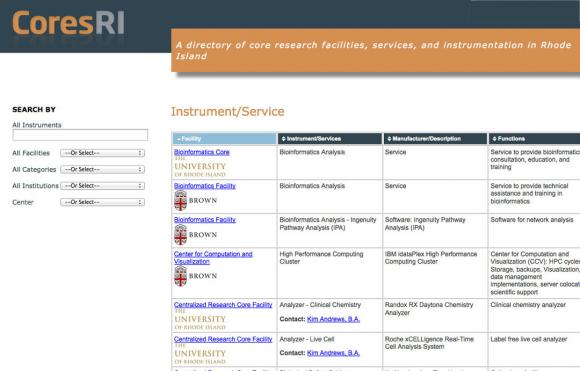PROVIDENCE, R.I. [Brown University] — Academic and medical institutions from around Rhode Island today unveiled CoresRI.org, a Web directory of publicly shared core science facilities and services that officials said could accelerate research collaboration for the benefit of the entire state.
CoresRI.org readily serves up detailed information on more than 500 lab instruments and services available in more than 30 core facilities and laboratories at 12 institutions. Site visitors — scientists, engineers or physicians — can search by institution, facility, general application or any keyword to find electron microscopes, high-throughput gene sequencers, nuclear magnetic resonance spectrometers, bioinformatics services and many other resources.
The site helps fulfill and expand on the promise of shared core facilities, which are designed to make expensive scientific resources, such as high-end equipment and expert staff, available to a broad scientific community. Otherwise researchers would struggle to acquire those resources just for themselves and then they might not be used to full capacity.
“Research is very technology-driven and so access to instrumentation is really critical,” said Edward Hawrot, the Alva O. Way University Professor of Medical Science at Brown and associate dean for the Program in Biology in the University’s Division of Biology and Medicine. “Having a searchable database is a big advantage.”
Peter Snyder, senior vice president and chief research officer for the Lifespan health system and a professor of neurology in the Alpert Medical School, said CoresRI.org provides an important new tool to promote scientific productivity and cooperation.
“This collective cataloguing of all core facilities, spanning all of the major research institutions across the State of Rhode Island, will allow any of our investigators – no matter where they are located or where their salary is drawn from – equal access to critical resources to support scientific research,” Snyder said. “This is an entirely unprecedented first step for all of our partner institutions, and I see this as the start of a new era of inter-institutional support and cooperation to grow our research activities and to bring new grants and contracts to our state.”
Scientists, engineers and physicians do not need to work at any of the inaugural partner institutions – Brown University, Lifespan, Care New England, the University of Rhode Island, the Providence V.A. Medical Center, the Rhode Island School of Design, Providence College, Bryant University, Community College of Rhode Island, Rhode Island College, Salve Regina University and Roger Williams University – to use the site or arrange access to facilities listed there. A state environmental researcher, for example, could use CoresRI to find the spectrometer needed to test for an unusual chemical in a water sample, or a physician at an independent hospital could seek space in an ultracold freezer for a tissue specimen.
Many benefits
Hawrot said the site’s partners anticipate many benefits from the new site beyond the most obvious one of facilitating researchers’ access to needed equipment. CoresRI.org can make state researchers more competitive in applying for grants, he said, because they’ll be able to show that they have access to relevant instruments even if they aren’t at their home institution. The site also can help inspire new research collaborations as researchers discover what each other can do.
Another benefit, Hawrot said, will be in recruiting researchers to the state because they can see the full spectrum of available resources within the state’s small geography.
CoresRI could also aid long-term economic development by helping scientists at a startup companies accomplish research and development tasks, said Pam Swiatek, director of research operations in Brown’s Division of Biology and Medicine.
Dr. James Padbury, a pediatrician and researcher at Women & Infants Hospital and professor of pediatrics in the Warren Alpert Medical School, said CoresRI.org will also help the state’s researchers make the most of the resources they share.
“Additional benefits beyond knowledge of and access to this equipment are coordination of shared equipment grants among investigators, avoidance of duplication on equipment purchases, and conservation of valuable resources to sustain these core labs at each of our institutions,” Padbury said. “In these days of tight federal and foundation budgets, collaboration across core laboratories in equipment use and sustainability will help us to use our precious resources most efficiently.”
Swiatek said the partners have a process for keeping the site up-to-date, a step that Snyder said will be key to the site’s success.
“CoresRI.org will be a ‘living’ site that will be updated regularly, allowing any scientist or trainee to easily find the equipment or specialty services they need to succeed in their work,” Snyder said.

